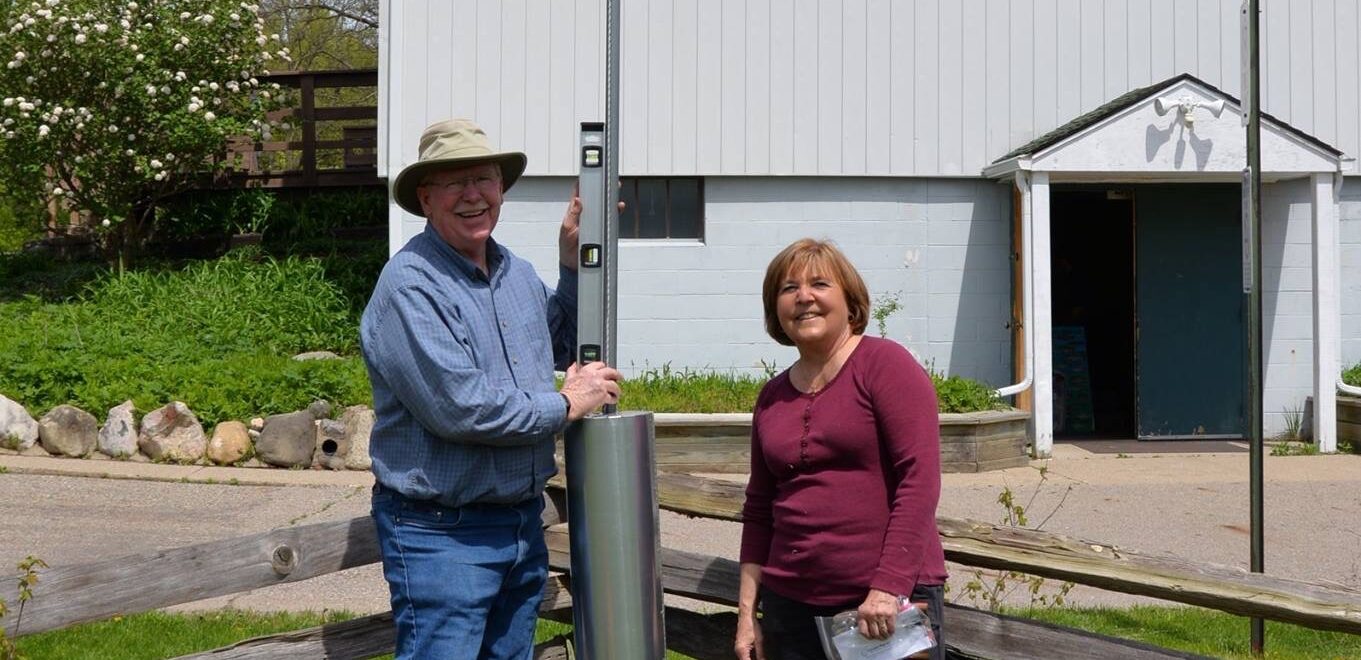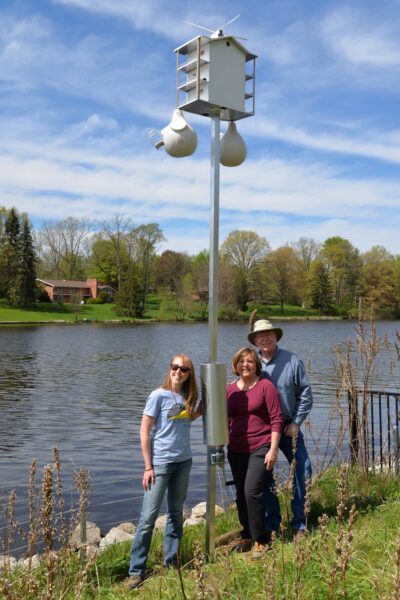
Penny and Rick Briscoe have assisted Michigan Audubon with the installation of numerous purple Martin houses since 2017, helping the Mi Bird-Friendly Communities initiative grow.
Penny and Rick Briscoe have been sharing their love for Purple Martins through their constant care at their colonies and converting their properties into bird-friendly habitats for decades — all while volunteering for Michigan Audubon and spreading their enthusiasm for aerial insectivores.
Tell us about yourselves — where are you from and how did you get into bird conservation?
Penny: I am a lifetime Michigan resident — I grew up in a relatively country-like setting just outside of Rochester and always had birds and other Michigan wildlife around. Although I was not exposed to “birding,” per se, I learned to identify and appreciate the more typical species.
My parents took us on many road trips all over the U.S., and they always involved outdoor experiences, and we always camped. I benefited from my mother’s curiosity for the natural places we visited and my father’s willingness to drive the family station wagon all over the country, loaded with camping gear and his wife and six children. After I married Rick, we raised two boys and carried on the tradition of camping with them.
Every year I learn more about birds and the environment, and I became a Master Naturalist through Michigan State Extension Services a few years back.
You are active Purple Martin landlords and have thriving colonies at two properties. How long have you been doing this, and what initially inspired you to put up housing for Purple Martins?
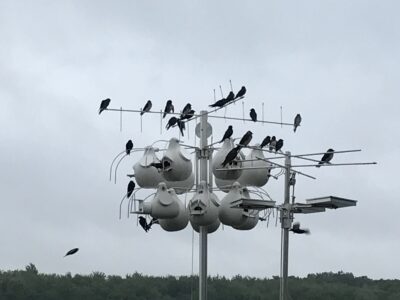
Purple Martins at the Briscoes’ colony on Barton Lake.
Penny: Our first colony began with a Christmas present to me of a Purple Martin house in 1985. I remembered seeing the birds as a child when visiting my uncle’s cottage on Saginaw Bay. We were blessed with Purple Martins that very first year and have had them ever since. The colony is now much expanded, and we have three poles with gourd racks that provide gourds for 28 pairs. We are usually close to full.
My intense interest in helping this bird through colony management really began in 2010 when cold, rainy weather struck one July while we were traveling. Most of our colony’s chicks perished due to a lack of bugs being available. At the time, I did not know about managing the colony and discovered the dead nestlings only after taking the housing down to clean it that September. I was shocked by what I found and vowed never to let this happen at my colony again.
Rick: This incident inspired her to become passionate about significantly impacting the future of these amazing birds. Since that time, we — Penny mainly — have truly managed our colony to maximize the positive outcome of the nesting activity each year. In 2015, Penny found a perfect 5-acre property along the St. Joseph River where she could start another colony. It took four years to attract birds, but we now have a small but well-established colony on that property.
Penny: We purchased the property to maintain a bird/nature habitat. Many people have been surprised that we would buy property for birding and naturalization. Still, I remind them that it is not any different than purchasing property for hunting, which many people are known to do.
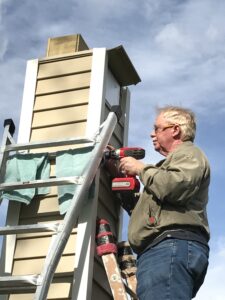
Rick Briscoe puts the finishing touches on the Chimney Swift tower he erected on their property in Mendon.
You’ve also built and installed Chimney Swift nesting towers. Rick, as chief builder, why did you become interested in doing this and have you seen any Chimney Swifts yet?
Rick: Three years ago, as Michigan Audubon began focusing on Purple Martins and Chimney Swifts, I got inspired to build a Chimney Swift tower as a birthday gift to Penny. The first one was quite a challenge, and I think I spent nearly 200 hours building and installing it on the property. I have since become much more adept at this project and was honored to assist a school group and Michigan Audubon with their builds. Last fall, we saw a small group of Chimney Swifts in our tower area, but I am not sure that any have used it yet. I will climb to the top this spring to see if there is any evidence of nesting.
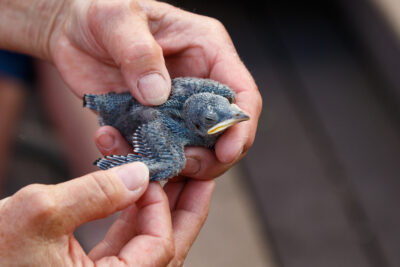
A Purple Martin chick is inspected before it is banded at the Briscoe colony.
How are you involved in the community regarding environmental topics or bird-related activities?
Penny: I have given numerous presentations over the last ten years about Purple Martins, whose numbers have been declining significantly since at least the 1960s, and hosted multiple field trips to our Barton Lake colony. I am listed on the Purple Martin Conservation Association website as a mentor for this species and am quite busy in the summer fielding questions over the telephone and through email, and I have made many home visits to help people position their housing. I continue to seek out ways to expand the knowledge of others so they will appreciate this species, especially by involving children, including my grandchildren, in the management of the colonies. We have also had Rich and Brenda Keith, from the Kalamazoo Nature Center, band the roughly 100 Purple Martin chicks at our Barton Lake colony, for the last three years.
One of my main goals is to encourage people to put up more housing and teach them how to manage it. As a result of the increased publicity for these birds because of programs like Michigan Audubon’s Mi Bird-Friendly Communities initiative, I have been pleased that more housing is being erected and I get reports of more Michigan colonies being established.
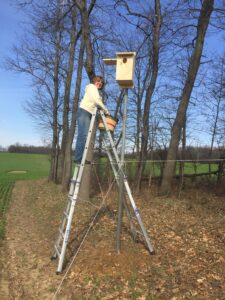
Penny adds cedar shavings to a nest box for American Kestrels. Rick has made numerous birdhouses for their five acres in Mendon along the St. Joseph River.
What do you see as the most important issue of bird conservation?
Rick: I think the most pressing need for bird conservation is habitat conservation. Humans have encroached on so much of the natural habitat of birds that they are struggling to adjust.
Penny: Habitat preservation is absolutely imperative. There are so many environmental problems out there, but with no habitat, there can be no nesting. Because of this I advocate being supportive of legislation and efforts to preserve land in its natural state and that people learn all they can about improving the habitat in their own backyards and change their thinking about having everything “tidy.”
What advice do you have for someone who wants to be involved with bird conservation but doesn’t know where to start?
Penny: Grass does nothing for the birds, so if possible develop areas in your yard that can be planted with native trees, bushes, and flowers. If people own larger properties, they can slowly convert their areas to natives, little by little, and find places to allow for brush piles! Again, don’t be too tidy. I personally have learned to put up with less “perfection” in the garden because I have embraced the unparalleled beauty of birds of many species coming to our property. Take a Master Naturalist class if you are a layperson like me and need a kick start. And remember that for the most part, native insects are good. If there are no insects, there will be no birds around!
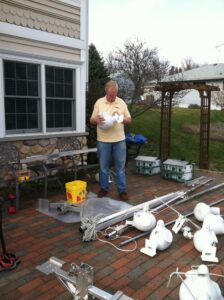
Rick numbers the Purple Martin gourds so he and Penny can keep track of what is happening in each for research purposes. The data collected is sent to the Purple Martin Conservation Association.
Rick: An approach for individuals could be to provide supplemental food, water, and housing. It is important to do some research or seek expert advice on how to best do this. It is also critical to remember that you are doing this for the birds, not for you. By that I mean that feeding and housing should be placed where it is best for the birds, not for human convenience. Start simple and enjoy success, but watch out as you can easily become hooked and will find yourself devoting many enjoyable hours on behalf of the birds.
Thank you, Penny and Rick, for all that you do for the birds!
This article appeared in the 2021 Spring Jack Pine Warbler.

